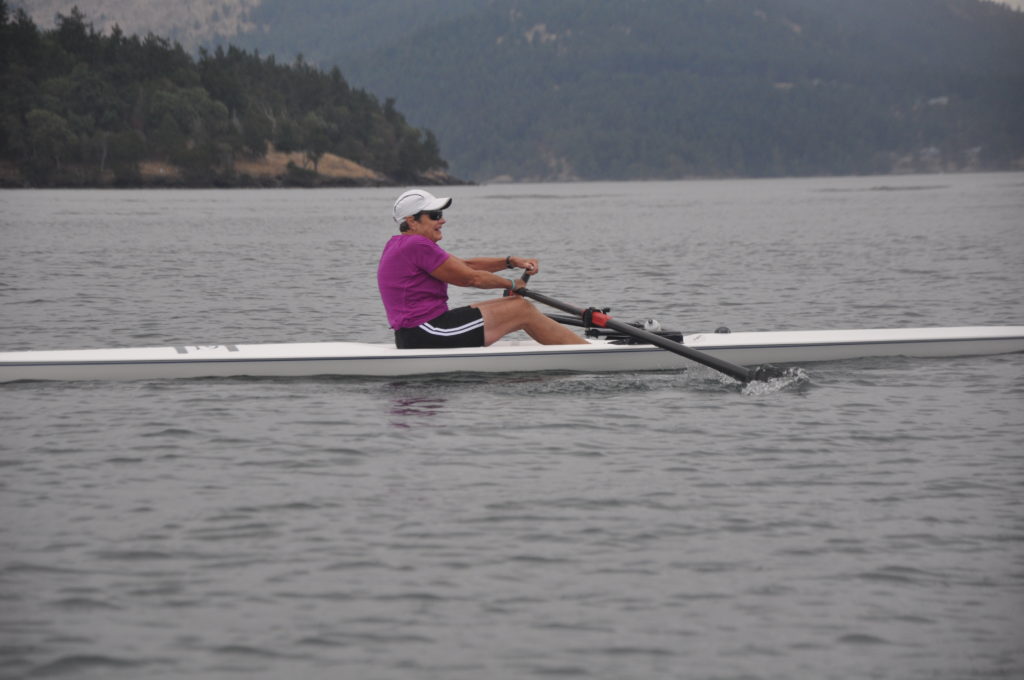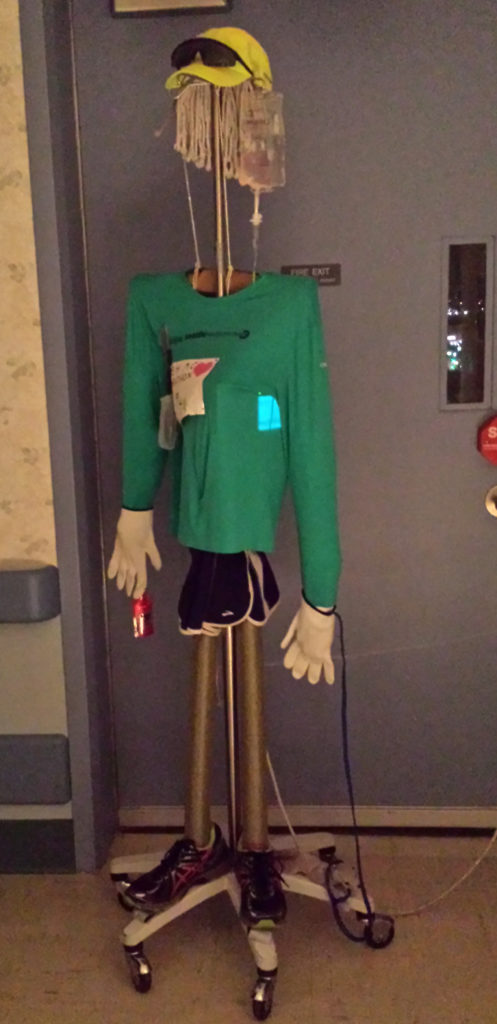Triathletes know how to suffer. They compete in high temps and high winds, and through intestinal distress, heat exhaustion, and debilitating cramps. Pat Johnson knows this as well as anyone. She’s completed 14 Ironmen and competed four times in Hawaii, where the 110-mile bike across the lava fields can spike above 110 degrees. She’s also finished dozens of marathons and century bike rides. But when it comes to discomfort, she can one up most athletes. Johnson has been shocked by electricity mid-race to restore the rhythm of her heart and prevent cardiac arrest.
She remembers it happening during the Seattle Marathon. “It’s like getting kicked in the chest by a donkey,” she says. But she did what she had trained herself to do: she kept running.
This was one of hundreds of times that electricity was used to correct her irregular heartbeat. In 2000 she had a defibrillator the size of a small tape measure installed in her chest. She asked for it to be placed under her peck muscle so it wouldn’t be visible through bathing suits and race bibs, and to be able to put out of mind, at times, the looming reality: someday she would need a heart transplant.
The defibrillator helped control life-threatening arrhythmias, but it could not repair the muscle. Johnson’s heart was growing larger and larger and less efficient. Each pump circulated less blood through her body. Doctors suspected she had contracted a virus, and that it wasn’t the virus that caused the damage; instead, her heart was more likely compromised by her body’s attempts to fight the virus.
At times her heart rate spiked to more than 269 beats per minute. “I got shocked driving, sitting, and swimming. There was no message of don’t do this.” So she tried to keep doing everything. And while other athletes nursed overuse injuries, she pounded various cocktails of drugs and tried to keep from getting too rattled by the shocks.

Her first ambition after receiving the defibrillator was a half-Ironman. “They wouldn’t let me do a full Ironman,” she says. “So I signed up for a half-Ironman at Troika instead to please the doctors.” Actually, she assumed that cutting her distance in half would please the doctors. “I didn’t ask about doing the half. I just did it.” She also competed in marathons. She reasoned that, if she was going to get shocked anyway, she might as well get shocked while doing what she loved.
You might think an athlete this determined had been competing all her life. But Johnson remembers her first run, which she tried soon after graduating from the University of Idaho Law School in 1977. She wore Keds and a bulky pair of cotton sweatpants. “My knees started hurting, and I learned there was such a thing as running shoes,” she says. To this day she still doesn’t know what inspired her to go on the first run or sign up for her first race—the Bay to Breakers in San Francisco. But she enjoyed the feeling of attempting and accomplishing something new.
Eventually, even with the assistance of the defibrillator, medications, and embolization treatments, hills on the bike got harder. She remembers sitting in a meeting in 2014 and experiencing more shocks than usual. One of her friends called an ambulance, and Johnson was sent to a hospital in Coeur d’Alene then transferred to Sacred Heart. They told her the time had finally come. After 14 years of managing her symptoms, the doctors said her heart had grown too large and could not keep her alive much longer.
Most prospective heart recipients are under 65. This could have been the end of the road for Johnson, since she was 64. But they admitted her to the hospital, put her on the transplant list, hooked her up to IVs and machines, and continued managing her medications while they waited. While positivity and an active lifestyle couldn’t keep her heart from failing, those factors did make her a strong candidate for a transplant, despite her age.

Johnson was no stranger to being treated for ailments. She had split her head open on bike rides, aspirated on water, and come close to heat stroke. But this was different. She knew she might be in the hospital for months. So much of what was happening to her was outside of her control, but she decided to focus on what she could do, instead of what she couldn’t. Johnson knew that she couldn’t keep her heart from getting any sicker, but she could stay as fit as possible and make her recovery down the road easier. She started walking four miles a day around the cardiac floor at Sacred Heart and got to know all of the nurses and patients.
She focused on staying as positive as possible “People kept asking me, Are you scared? They’re going to take your heart out. I said, No, I’m excited!” She couldn’t wait to return to the activities and life she loved.
Even though Sacred Heart has been named one of the top cardiovascular hospitals in the country, her optimism could be hard to believe. No one who suffers from a life-threatening illness should be relentlessly optimistic. But this positivity didn’t only originate in Johnson’s innate toughness, even though she has grit in spades. Her optimism was also grounded in her trust of people.
As she mentally prepared for the surgery, she remembers asking the hospital staff, “Is this going to hurt?”
They replied, “No, honey, we’re gonna take care of you.”
She leaned into their promise and found ways to stay busy. She brought in a portable printer, a small computer table, and an office chair and set up a makeshift law office. She had taken on major projects with her partners at Advocates Law Group and kept going with that team. Between check-ins with nurses and doctors, she was frequently able to pack in a full workdays.
Johnson also enjoyed regular visits from friends and family. They helped keep the situation as light and entertaining as possible, in part by indulging in an imaginative take on one of her medical devices, who they named “Rhonda.”

You see, Johnson had started feeling chummy with her IV pole. The pole rolled down the halls beside her as she walked her 4 or more miles daily. The pole entered the bathroom with her and waited just outside the curtain while she showered. Eventually, Johnson put a t-shirt over the top, nestled shoes just above wheels, and named her Rhonda the Runner. Soon, friends were donating additional accouterments: a Dollar Store mop for hair, latex gloves for hands, and a juice box for a heart monitor. They also provided additional running gear like hats, sunglasses, and running shorts. Rhonda even accompanied her across the street on walks through the Healing Garden, and once her arms fell off and had to be reinstalled on the way.
10 weeks after being admitted to the hospital Johnson sat in her bed in a medical gown beside a stripped-down Rhonda, who the hospital staff had recently dismantled. The two had evolved together, and now a naked Rhonda would accompany Johnson where no other friends or family could go—into surgery.
The procedure went perfectly. Three days post-op, Johnson returned to her routine of walking 4 miles a day. She was allowed to do anything that didn’t aggravate her incision, which stitched the skin back together after they had sawed open her sternum. To celebrate the one-year anniversary of her surgery, she ran the Priest Lake Marathon.
Johnson knows she’s lucky. “People do have complications. It’s someone else’s organ that you manage with immune suppressant medications.” Her physical fitness prior to her transplant has nothing to do with whether her body accepted or rejected her new organ. But it does have something to do with how quickly she resumed an active lifestyle.
Johnson doesn’t know exactly how this experience has changed her because she’s too close to it; it’s impossible to separate yourself from a major incident and ask who you would have been without it. But she does stand in wonder of the heart.

Having a damaged heart as an athlete is so different from other kinds of injuries. She reflects on all the preventative measures athletes take to stay fit and healthy. “We think about healthy eating, but not about what the heart does. With the heart, there is nothing visible that says, I have a problem. It made me realize we don’t think about the fact that kidneys work or all that keeps us going. We think about muscles, joints, backs.” She thinks that we disassociate from the complexity and efficiency of our bodies. We tend to focus on little aches and pains but “don’t think about the whole.”
Currently Johnson is training for the Bainbridge Island Marathon—the longest single-day race for human-powered boats on the West Coast. She will row 26 miles in her 24-foot Maas single rowing shell. She loves her new watercraft community and says they require only three things to race: a PDF, a whistle, and a smile. Now 69, Johnson says she transitioned from running to rowing because “I don’t have cartilage left in my knees.” But she’s full of determination to push and challenge her whole body, including that miraculous heart.













